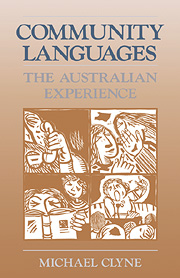Book contents
- Frontmatter
- Contents
- List of tables
- List of graphs
- Map of Australia
- Preface
- 1 Australia between monolingualism and multilingualism
- 2 Distribution and maintenance of community languages in Australia
- 3 The use of community languages in Australia
- 4 Structural and typological aspects of community languages
- 5 The formulation and implementation of language policies
- Appendix
- Glossary
- Bibliography
- Index
3 - The use of community languages in Australia
Published online by Cambridge University Press: 09 November 2009
- Frontmatter
- Contents
- List of tables
- List of graphs
- Map of Australia
- Preface
- 1 Australia between monolingualism and multilingualism
- 2 Distribution and maintenance of community languages in Australia
- 3 The use of community languages in Australia
- 4 Structural and typological aspects of community languages
- 5 The formulation and implementation of language policies
- Appendix
- Glossary
- Bibliography
- Index
Summary
INTRODUCTORY REMARKS
So far, I have put language maintenance and shift in Australia into a historical context and examined the statistical data on the distribution and fate of community languages. I have also attempted to isolate variables promoting language maintenance or shift, for explanatory and predictive objectives, in relation to various the oretical frameworks. Some of the data are general, others domainspecific, such as those relating to home use. This chapter will be devoted to the functions and domains in which community languages are employed in the supportive context of contemporary Australia. Due to the enormity of the data-gathering task, my data base will necessarily be limited. Where possible, 1986 statistics are given since this was also the year of our Census data.
DOMAIN AND CODE-SELECTION
From Chapter 2 we see that community languages are employed widely in private and public domains. The role of domain in the code-selection of bi-and multilinguals has been an important discovery in the sociology of language (Fishman 1965, 1966, 1985a; Cooper 1967; Greenfield 1970). Domains are contextualized spheres, or total interactional contexts of communication, such as home, work, neighbourhood, school and local religious unit. However, domains themselves are not the only significant factor in code selection. Sankoff(1971) shows that interlocutors (and their ethnic ascription, something which often correlates with age, see below) play an important role, even more so than situation, topic, style and medium.
- Type
- Chapter
- Information
- Community LanguagesThe Australian Experience, pp. 112 - 156Publisher: Cambridge University PressPrint publication year: 1991

